Unlike CATIA Version 4 (general 2D and 3D creation commands), to create one element, you no longer need to activate a group of specific commands (or creation scheme).
From Scratch
You can create geometrical elements by progressively specifying a given number of characteristic points. These characteristic points can be specified whatever the active Sketcher command. Characteristic points are pre-determined fictitious points managed by SmartPick which allow creating and manipulating geometrical elements whatever the complexity of the latter.
You will create some of these characteristic points with total freedom
(both horizontal and vertical degrees of freedom are available
![]() ), and
others with partial freedom (only one degree of freedom is available
), and
others with partial freedom (only one degree of freedom is available
![]() ).
).
You will find here below a non-exhaustive list with Sketcher elementary geometrical elements and corresponding characteristic points. SmartPick lets you position these points using one of the following: the cursor, the Sketch tools toolbar, the contextual menu, Shift or Ctrl key.
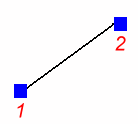 |
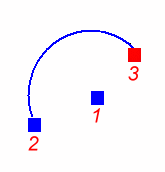 |
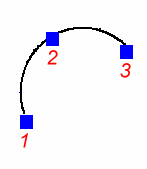 |
| A line | An arc (center radius) | An arc of a circle using three points |
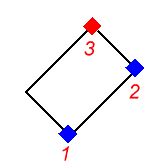 |
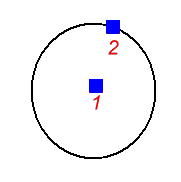 |
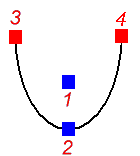 |
| An oriented rectangle | A circle | A parabola |
- positioning specifications (SmartPick cursor)
- external geometry (for example, two lines parallel to each others, or two coincident points)
- internal geometry characteristics (horizontal/vertical lines, quarter of arc of circles)
- the externalized parameters of a geometrical element (length, angle, excentricity and so forth)
According to Existing Geometry
Reference Geometry
SmartPick finds out geometrical specifications according to geometrical elements that already exist in a sketch.
You will only detect geometrical specifications according to the current sketch elements that are visible in the 3D window in which the cursor is positioned. You will not need to perform any interaction and you will be returned a visual feedback as shown below in a non exhaustive way:
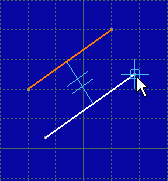 |
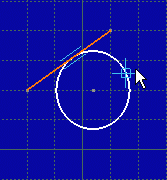 |
 |
| parallel (two lines) | tangent (a line and a circle) |
perpendicular (two lines) |
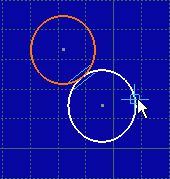 |
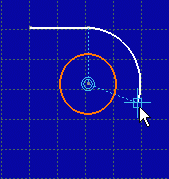 |
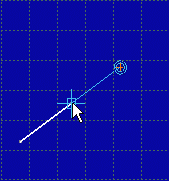 |
| tangent (two circles) |
concentric (a circle and an arc) |
coincident (curve through point on line) |
In addition to this classification, when several snapping are possible for a given type of geometrical constraint, SmartPick takes into account the distance between the snapped cursor and the geometrical element according to which the snapping is possible. In this case, SmartPick snaps to the nearest element.
Still, there are some cases when SmartPick does not allow dimensioning as desired without additional interactions. This is why SmartPick therefore manages two means for applying a particular snapping relatively to the geometrical elements.
Forcing the Snapping
SmartPick allows forcing the snapping on a given geometrical element using either:
- the contextual menu or
- the Ctrl key
Contextual Menu
SmartPick allows forcing the snapping on a given geometrical element using the contextual menu. You will avoid ambiguities linked to the automatic detection of elements in the current 3D viewpoint by forcing:
- snapping detected at a distance: parallel, perpendicular,
concentric, tangency and curve (line/circle) that goes through a point.
At a distance means that these constraints are detected even though the cursor is not positioned on the reference element. - snapping at a given position that is relative to a geometrical
element: line midpoint, circle center.
At a given position means that both degrees of freedom are locked.
The contextual menu is therefore available when right-clicking most Sketcher geometrical elements. Of course, the contents of the contextual menu depends of the element that is being currently created. This contextual menu can be made of the below four sub-parts:
- Option that belongs to the Base Infrastructure product.
- Snapping the characteristic point that is being manipulated (see From scratch paragraph and table below).
- Snapping the geometrical element that is being created (see table below).
- Managing the parameters that are associated to the geometrical element that is being sketched.
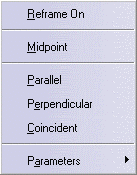
Deactivating Snapping
Any snapping that is imposed via the contextual menu can be de-activated. For this, right-click in the 3D window background and select Reset.
The table below lists the constraints that can be detected when snapping characteristic points which are being manipulated, relatively to existing geometrical elements, and thanks to the contextual menu.
| Popped-up Geometry | Available Snapping |
| Line | Line midpoint |
| Circle | Circle center |
| Ellipse | Ellipse center |
| Curve | Nearest end point |
| External Geometry | |||||||
| Element currently created | Point | Line | Circle | Ellipse | Conic | Spline | |
| Point |
|
Midpoint Nearest end point |
Center Nearest end point |
Center Nearest end point |
No | No | |
| Line |
|
|
|
|
|
|
|
| Ellipse |
|
|
|
No | No | No |
Example of snapping possibilities
In the example below, you can see the various snapping possibilities for a line that is being created (dotted lines in the example) relatively to the existing spline: 3 tangency possibilities and 2 perpendicularity possibilities. The point you right-click to display the contextual menu is used to determine which option will be offered in the contextual menu. So depending on where you click, you will not be offered the same options.
Note that the software takes into account what has already been specified (in this example, the first point of the line) to offer the various snapping options. For this reason, depending on the first point of the geometrical element that is being created, there may be cases in which no solution can be found or in which the solution offered does not correspond to what you want. In such a case, try to right-click before and/or after the point you want the software to choose. If you try both ways, one solution at least should be found.
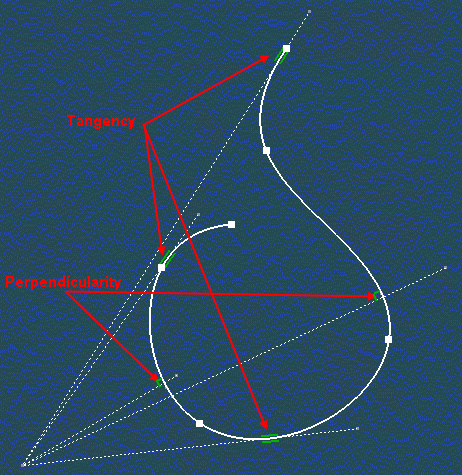
Ctrl Key
SmartPick also allows forcing the current snapping on an element using the Ctrl key:
- You can force SmartPick to remain snapped on an element whatever the position of the cursor. For this, you will press the Ctrl key while the geometrical snapping you want to force is active (the element may be highlighted and symbols may appear) and keep the Ctrl key pressed.
- This functionality is efficient if once the Ctrl key is pressed you can still move the cursor. In other words, Ctrl has no effect if the current snapping inhibits both degrees of freedom. This is often the case when given snapping combinations are possible (for example at the intersection of two lines) or when the cursor is close to a given point (explicit or implicit as for example the midpoint of a segment).
- The Ctrl key is very useful when the sketch includes many geometrical elements because SmartPick takes into account the distance between the cursor and the geometrical element.
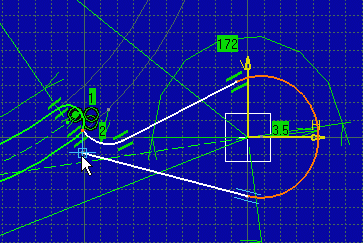
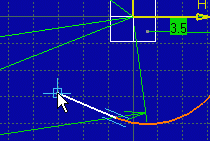
De-activating SmartPick
If SmartPick cannot solve an ambiguity and returns a snapping that you are not satisfied with, you can de-activate SmartPick assistant by pressing the Shift key.
Be careful: it can happen that either the Shift or Ctrl key do not behave as specified in the paragraphs above. In fact, sometimes the viewer loses the focus (selection priority). You can then perform a local transformation to recover the focus: use the middle mouse button and manipulate the viewpoint. You will thus recover the focus.
Detecting Internal Geometry Characteristics
Certain geometrical elements are assigned internal peculiar geometrical characteristics. For example and as shown below, this is the case for horizontal/vertical lines and for quarters of arcs of circles. When such an internal specification is found out by SmartPick, the color of the currently created geometrical element becomes blue.
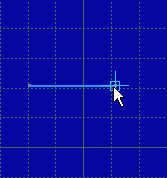
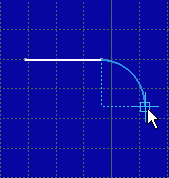
Managing Geometry Parameters
SmartPick also manages internal geometrical specifications such as a line length or a circle radius. Indeed, these specifications (further called parameters) decrease available degrees of freedom of a geometry characteristic point (refer to previous From Scratch paragraph). All these parameters are accessed through the Sketch tools toolbar which gathers all the available parameters that can be valuated for a given geometry creation command. Finally, while the SmartPick cursor moves, the Sketch tools toolbar displays the parameters value.
Listed below is a non exhaustive list of the possible looks of Sketch tools toolbar parameter section:
 |
Length and Angle to H axis are available for Line creation command. |
 |
Radius, Start Angle to H Axis or Angular sector are available for Arc Circle creation command. |
 |
Excentricity is available for Hyperbola creation command. |
Relation Between Parameters and Characteristic Points
There exist a strong relation between the characteristic point of a geometrical element and some of the parameters it supports. In fact, if a parameter value is modified by moving the cursor, it means that the parameter is linked to the current characteristic point and consequently validating the point will modify the parameter status.
Indeed, as when valuated a characteristic point can no longer be modified, associated parameters get frozen which is echoed by a grayed entry in the Sketch tools toolbar.
As an example, in Arc Circle creation command, when the arc start point is defined (at the sketch origin on this picture) both Radius and Start Angle to H Axis get frozen. Indeed, as the arc center is necessarily previously defined, to impose arc start point leaves no ambiguity on the radius and the start angle of the sector.
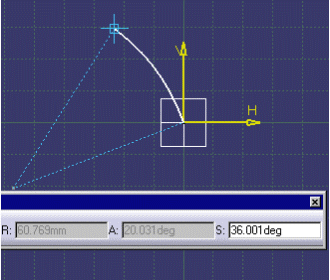
Specific Parameters
Some parameters have a specific behavior. This behavior is common to all geometry creation commands that use these parameters. This is the case for Angle and Sector parameters.
Sector Parameter
This parameter is oriented so that no ambiguity is possible when defining an angular sector. In the standard units system, an angle range is from -360 to 360deg. Any other value is recomputed to this range. Positive values are for direct sectors (you go from the start direction to the end one the same way you go from H axis to V axis). Negative values are on the other end for reverse arcs (you go from the start direction to the end one the same way you go from V axis to H axis).
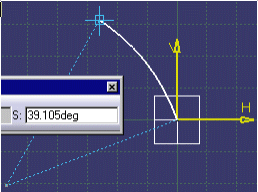 |
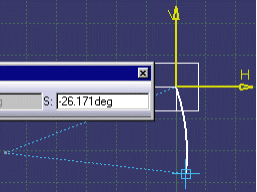 |
| A direct angular sector | A reverse angular sector |
Angle Parameter
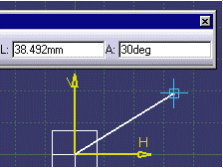 |
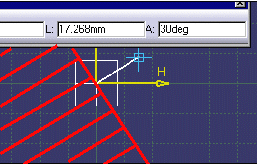 |
| A fixed 30 deg angle value imposed to a line | Note that when this angle is fixed, the cursor position is restricted to the half of the sketch plane. Indeed, otherwise a 30 deg angle would be equal to a 210 deg one which is excluded. |

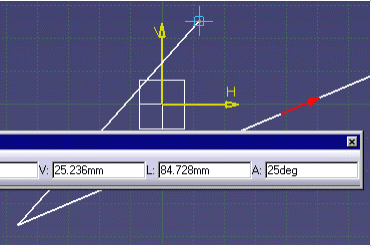
Copying Parameter Values
It is possible to copy some of parameters value from any existing geometrical element that can be defined with the same parameters. The Copy functionality is available through the contextual menu Parameter section for length and radius parameters.
Length can be copied from a line while radius from a circle or an arc.